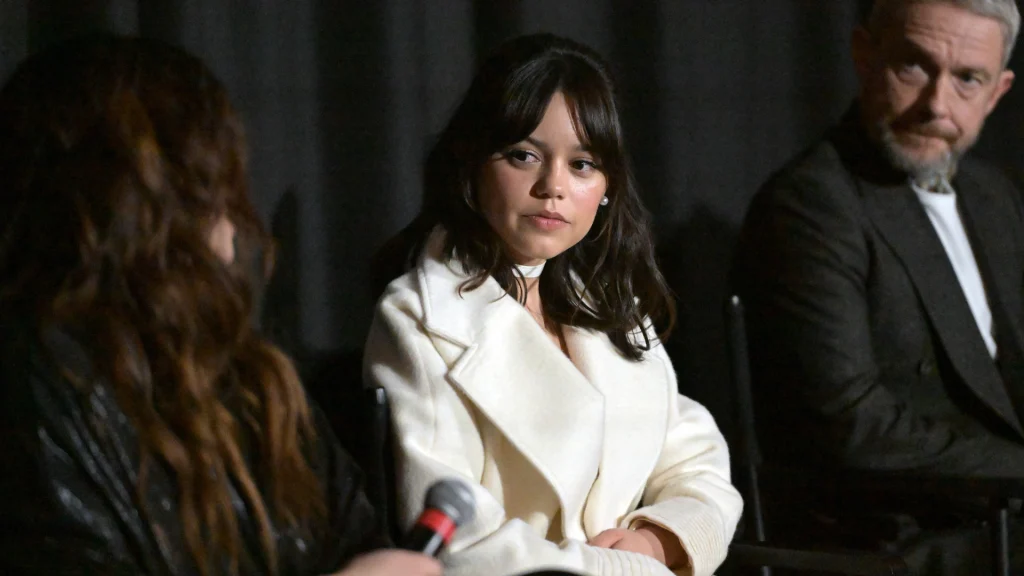The Jenna Ortega deepfake scandal is a stark reminder of the bad side of innovation in a world full of amazing technology advances. Imagine a world where it’s hard to tell the difference between truth and manipulation and where innocent faces are changed into tools for taking advantage of people. This is the scary truth that came out with the rise of deepfake technology, casting a shadow of doubt and fear over the ideas of privacy and permission.
The blog talks about the Jenna Ortega deepfake incident and what it means, such as how appealing deepfake apps are and how they violate people’s rights. It talks about the moral problems caused by the large number of fake naked pictures that go against social rules and digital limits.
Introduction to the Jenna Ortega Deepfake Scandal
Deepfake videos have become popular and problematic in recent years. One of the most well-known cases involves the young actor Jenna Ortega. Deepfakes are fake videos, pictures, or sounds that have been changed or created using programs that use artificial intelligence (AI). People, like Jenna Ortega, can look like they are saying or doing things they never actually did with these high-tech products. Jenna Ortega, who is famous for her parts in TV shows and movies, was scammed by this harmful technology when fake videos of her started going around on social media sites. The Jenna Ortega deepfake incident got a lot of attention right away and brought up important issues of privacy, consent, and how these things affect people and society as a whole.
The deepfake videos of Jenna Ortega were made using advanced AI algorithms to change her picture and make it look like she was doing inappropriate or revealing things. Then, these fake videos, in which she never actually appeared, were shared on many social media sites, causing her a lot of stress and hurting her image. The Jenna Ortega deepfake scandal is a stark warning of how dangerous deepfake technology can be. It shows how important it is to raise understanding, make rules stricter, and protect people better from the spread of manipulated media. As we learn more about this story, it’s clear that it affects a lot more than just one person. They cover more general problems like privacy, consent, and keeping our digital world safe.
The deepfake scandal involving Jenna Ortega should serve as a wake-up call for society to deal with the growing danger that deepfake technology poses, safeguard people from its bad effects, and create a safer online space for everyone.
You may also like: Mati Marroni Leaked Photos Controversy
Deepfake Technology
Artificial intelligence and machine learning algorithms are used by deepfake technology to make fake movies that look real by putting someone else’s face on the real subject. People find it hard to spot this method because it exactly copies facial expressions, movements, and voice patterns. When deepfakes are used, they blur the line between reality and fiction, which can be bad for privacy and consent. It’s important to spread the word about deepfakes and be careful when you see videos or pictures that don’t seem right, because they’re always changing and looking more real.
The Implications of Underage Celebrities Being Targeted
Deepfake technology is a big problem for underage celebrities because it hurts their mental health, crosses personal limits, and spreads harmful stereotypes. It can also hurt a celebrity’s image and make it harder for them to get a job. Content that has been changed can quickly go viral, making it hard for celebrities to get back control of their image. This problem makes it clear that stricter rules and technology solutions are needed to protect the rights and well-being of young people.
The Disturbing Deepfake Ads Featuring Jenna Ortega

Jenna Ortega, a child actress known for her parts on Disney Channel shows, has been a victim of deepfake ads. These are videos or images that have been changed by using AI to put someone else’s face on top of another person’s body. These ads, which were shared on popular social media sites like Instagram and Facebook, showed fake naked pictures of Jenna, which used her image for profit and hurt her name. These deepfake ads are bad because they invade people’s private and personal space and put their mental health at great risk. Social media sites like Instagram and Facebook need to make their rules harsher to stop the spread of such explicit material.
Privacy, Consent, and Legal Ramifications
The deepfake incident involving Jenna Ortega shows how important privacy, consent, and the legal effects of deepfake technology are. Using someone’s image without their permission is against their privacy rights and makes it hard to tell the difference between reality and fiction. People can be hurt emotionally and have their professional names hurt by deepfakes. When deepfake causes harm, it can be hard to figure out who is responsible, how to enforce the law, and what jurisdiction applies. To protect privacy, consent, and well-being, people, social media companies, and lawmakers must work together.
Impact on Society and Online Safety
Deepfake videos affect society and online safety in major ways. As this technology improves, the potential harm increases. Here are key points:
Mistrust and Deception
Deepfakes blur reality and fiction lines. It’s harder to tell what’s real when videos are manipulated. This impacts trust in visual media. It affects public understanding and causes reputational damage.
Online Harassment Risks
Deepfakes threaten privacy and online safety. Bad actors create fake intimate videos without victims’ consent. This leads to harassment, defamation, and emotional distress. Sharing amplifies harm potential
Cyberbullying and Non-Consensual Content
Deepfakes worsen cyberbullying and revenge porn issues. Anyone can create and share explicit content without permission. Not just public figures, but ordinary people too. Mental health and legal concerns arise.
Political Influence
Deepfakes manipulate public opinion through fake but realistic videos. This sways voters, undermines democracy, and causes social unrest during elections and political events.
Social media has a big problem. There is too much fake content made with computers. Fake videos and images can spread false ideas and harm people. It is hard to find this bad content and get rid of it quickly. There are so many new posts every day that it is difficult to check them all.
To stop these computer fakes, we need to work together. New technology can help find them better. Laws could also make rules against making them. Teaching people to spot fakes is important, too. By using many solutions, we can create a safer internet for everyone.
Battling Deepfakes: Measures to Combat Manipulated Content
Safeguarding individuals from deepfakes’ detrimental impacts is crucial. Various countermeasures combat manipulated content’s spread, protecting privacy. Key initiatives include:
- Researchers persistently enhance detection algorithms, developing tools to identify and flag deepfake videos – vital efforts against this harmful content’s proliferation.
- Governments implement laws holding deepfake creators/distributors accountable, establishing legal frameworks with penalties to deter non-consensual deepfak
- Educational campaigns raise deepfake awareness, informing the public about this technology’s existence, implications, and identifying/reporting fake content.
- Collaboration among tech companies, social platforms, and creators shares information, best practices, and technological solutions for a safer online environment.
Fighting deepfakes demands sustained vigilance. Technology constantly evolves, so we need relentless effort. We win by working together. This protects people and secures safe digital environments for everyone.

